Incorporating Outdoor Elements in Your Indoor Modular Kitchen: A Biophilic Approach – Delving into the world of modular kitchens, we uncover the captivating concept of integrating the outdoors within your culinary haven. This innovative approach, rooted in biophilic design principles, promises to transform your kitchen into a vibrant and rejuvenating space, fostering a harmonious connection with nature.
As we delve deeper into this topic, we’ll explore the myriad ways to seamlessly blend natural elements into your modular kitchen, creating a symphony of functionality and aesthetics. From the tactile warmth of natural materials to the invigorating presence of indoor plants, every element will contribute to a kitchen that not only serves as a culinary hub but also a sanctuary for your well-being.
Biophilic Design Principles
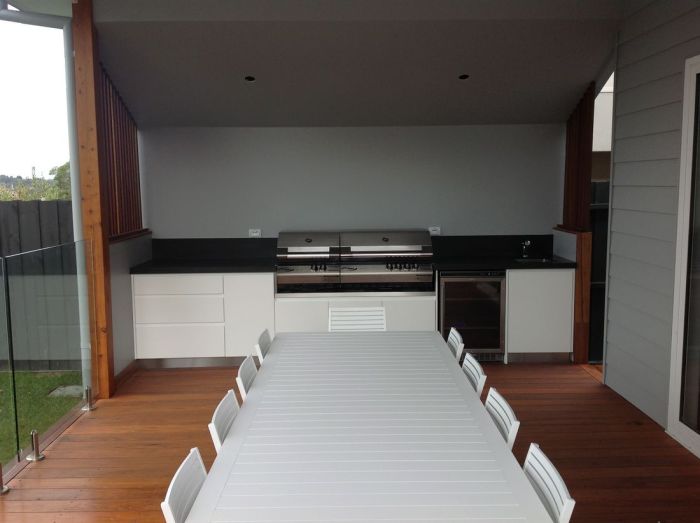
Integrating nature’s elements into indoor spaces, known as biophilic design, offers numerous benefits. It enhances well-being, reduces stress, and boosts creativity. In a modular kitchen, biophilic design principles can be applied to create a harmonious and invigorating environment.
Natural elements can be incorporated into a modular kitchen in various ways:
Natural Lighting
- Maximize natural light through large windows or skylights, which promotes alertness and reduces eye strain.
- Consider installing dimmable lights to adjust the brightness based on the time of day and activity.
Natural Materials
- Use sustainable materials like bamboo, reclaimed wood, or stone countertops, which bring warmth and texture to the space.
- Incorporate plants and herbs into the kitchen to purify the air and add a touch of greenery.
Natural Patterns
- Incorporate organic shapes and patterns into the kitchen design, such as curved cabinetry or a patterned backsplash.
- Use natural textures like wood grain or stone to create a sense of depth and visual interest.
Natural Colors
- Choose a color palette inspired by nature, such as earthy tones, greens, or blues, which promote calmness and tranquility.
- Add pops of color through accessories or artwork to create a vibrant and inviting atmosphere.
Natural Materials and Finishes
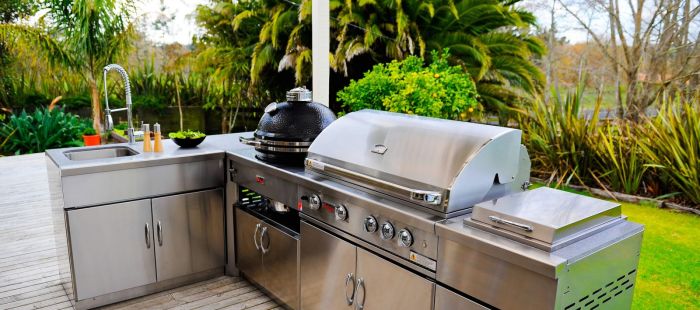
Incorporating natural materials and finishes into your modular kitchen can create a warm and inviting atmosphere while promoting sustainability. These materials bring the beauty of nature indoors, enhancing the overall aesthetic and well-being.
Wood
Wood is a classic choice for kitchen cabinetry, countertops, and flooring. It offers a timeless elegance and natural warmth. Different types of wood, such as oak, maple, and walnut, provide a range of colors and grain patterns to complement any design style.
- Advantages:Durable, easy to clean, warm and inviting, adds character to the space.
- Disadvantages:Can be susceptible to scratches and dents, requires regular maintenance to maintain its appearance.
Stone
Stone is a durable and elegant choice for kitchen countertops and backsplashes. It is heat-resistant, scratch-resistant, and easy to clean. Natural stone options include granite, marble, and quartz.
- Advantages:Durable, heat-resistant, easy to clean, adds a luxurious touch to the kitchen.
- Disadvantages:Can be expensive, requires sealing to prevent staining, may be cold to the touch.
Bamboo
Bamboo is a sustainable and eco-friendly choice for kitchen cabinetry and flooring. It is a rapidly renewable resource that is durable and resistant to moisture. Bamboo comes in a variety of colors and textures.
- Advantages:Sustainable, durable, moisture-resistant, adds a unique and modern touch to the kitchen.
- Disadvantages:Can be more expensive than other materials, may not be as scratch-resistant as wood or stone.
Indoor Plants and Greenery
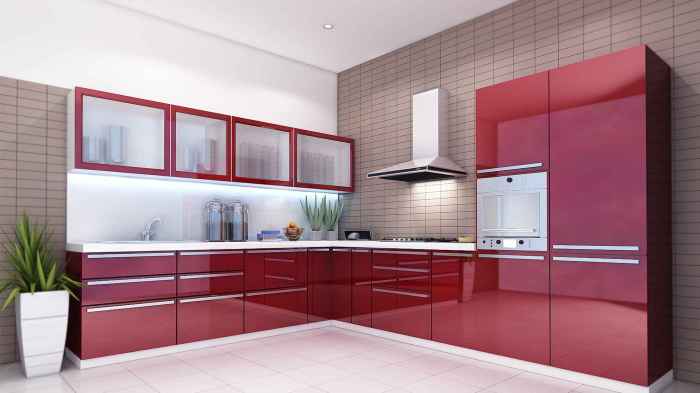
Incorporating indoor plants and greenery into your modular kitchen is an excellent way to bring a touch of nature indoors, creating a more inviting and natural atmosphere. Not only do plants add a splash of color and freshness, but they also offer numerous benefits for your well-being, including improved air quality, reduced stress levels, and enhanced creativity.
Choosing the Right Plants
When selecting plants for your modular kitchen, consider the following factors:
- Light conditions:Choose plants that are suitable for the amount of natural light available in your kitchen. If your kitchen receives ample sunlight, you can opt for plants that thrive in bright light, such as succulents, cacti, or herbs.
- Space constraints:Modular kitchens often have limited space, so it’s important to choose plants that are compact and won’t overwhelm the area. Consider hanging plants, vertical gardens, or small tabletop plants.
- Maintenance:Choose plants that are relatively easy to care for and require minimal maintenance. Some low-maintenance options include snake plants, ZZ plants, or peace lilies.
Caring for Your Plants
To ensure your plants thrive in your modular kitchen, follow these care tips:
- Water regularly:Water your plants according to their individual needs, taking into account factors such as plant size, soil type, and light conditions.
- Provide adequate light:If your kitchen doesn’t receive enough natural light, consider supplementing with artificial light sources, such as grow lights.
- Fertilize occasionally:Fertilize your plants every few months to provide them with essential nutrients.
- Prune regularly:Prune your plants to remove dead or overgrown leaves and encourage healthy growth.
Natural Light and Ventilation
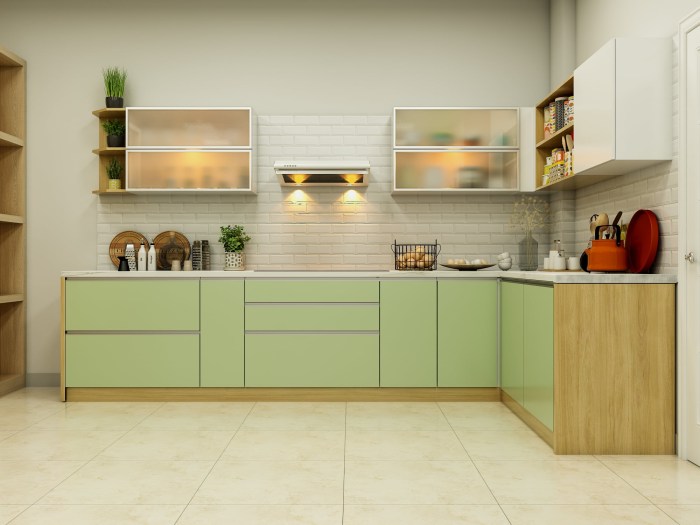
Incorporating natural light and ventilation into your modular kitchen can create a more inviting and comfortable space. Natural light can help to improve your mood and energy levels, while ventilation can help to remove cooking odors and fumes.
There are several ways to maximize natural light in your kitchen. One option is to install windows that allow in plenty of sunlight. Another option is to install skylights, which can provide even more light. If you have a small kitchen, you can still incorporate natural light by using reflective surfaces, such as mirrors or white paint, to bounce light around the room.
Good ventilation is also important in a kitchen. Ventilation can help to remove cooking odors and fumes, which can be harmful to your health. There are several ways to incorporate ventilation into your modular kitchen. One option is to install a range hood, which can help to remove cooking fumes.
Another option is to install a ceiling fan, which can help to circulate air. You can also open windows and doors to allow fresh air to circulate.
Maximizing Natural Light
- Install windows that allow in plenty of sunlight.
- Install skylights to provide even more light.
- Use reflective surfaces, such as mirrors or white paint, to bounce light around the room.
Incorporating Ventilation
- Install a range hood to remove cooking fumes.
- Install a ceiling fan to circulate air.
- Open windows and doors to allow fresh air to circulate.
Outdoor Views and Connections
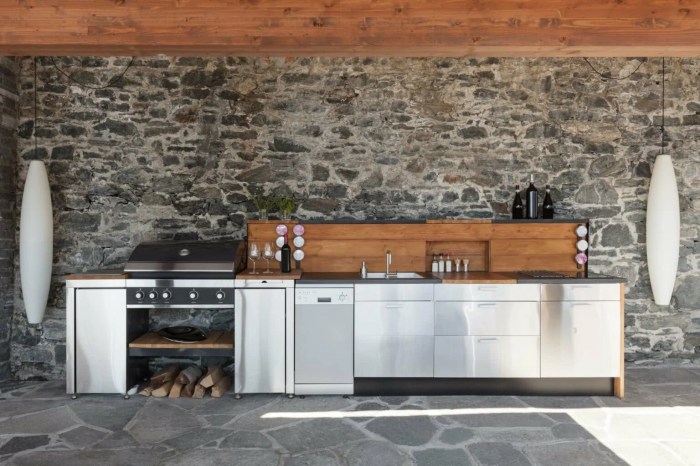
Incorporating outdoor views and connections into your indoor modular kitchen can bring a sense of nature and tranquility to your cooking space. It can also help to create a more inviting and relaxing atmosphere.There are many benefits to having views of the outdoors from your kitchen.
Natural light can help to improve your mood and energy levels. It can also make your kitchen feel more spacious and airy. Outdoor views can also provide a sense of connection to the natural world, which can be calming and restorative.
Creating Seamless Connections, Incorporating Outdoor Elements in Your Indoor Modular Kitchen
There are several ways to create seamless connections between your indoor and outdoor spaces. Large windows and sliding doors can provide a clear view of the outdoors and allow you to easily move between the two spaces. Outdoor patios and decks can also be a great way to extend your kitchen into the outdoors.
Conclusion
Incorporating outdoor elements into your indoor modular kitchen is not merely a design trend; it’s a conscious choice to enhance your living experience. By embracing the principles of biophilic design, you can create a kitchen that nourishes your senses, fosters creativity, and promotes overall well-being.
As you embark on this transformative journey, remember that every natural element you introduce brings a piece of the outdoors into your home, creating a space that is both beautiful and restorative.
FAQ Guide: Incorporating Outdoor Elements In Your Indoor Modular Kitchen
What are the benefits of incorporating outdoor elements into an indoor kitchen?
Integrating outdoor elements into an indoor kitchen offers a multitude of benefits, including improved air quality, reduced stress levels, enhanced creativity, and a stronger connection to nature.
What types of natural materials can be used in a modular kitchen?
A wide range of natural materials can be incorporated into a modular kitchen, such as wood, stone, bamboo, cork, and leather. These materials bring warmth, texture, and durability to the space.
How can I choose the right plants for my modular kitchen?
When selecting plants for your modular kitchen, consider factors such as the amount of natural light available, the size of the space, and the level of maintenance you’re willing to provide. Some popular choices include herbs, succulents, and air-purifying plants.
